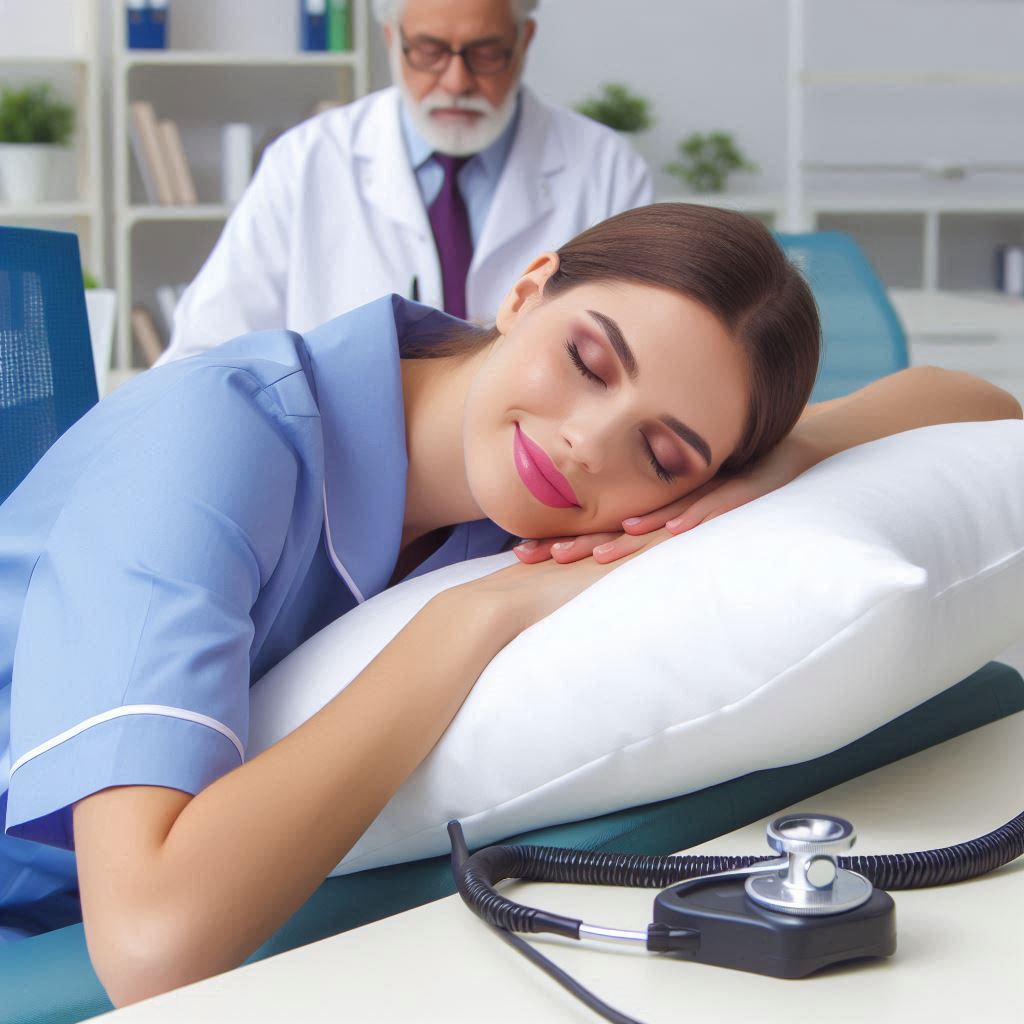Introduction
Sleep studies, also known as polysomnography, are comprehensive tests used to diagnose sleep disorders by recording a variety of physiological data during sleep.
These studies monitor brain activity, eye movement, muscle tone, heart rate, respiration, and oxygen levels.
They provide detailed insights into the patient’s sleep patterns, identifying disruptions or abnormalities.
The importance of sleep studies in diagnosing sleep disorders cannot be overstated.
Sleep disorders such as sleep apnea, insomnia, narcolepsy, and restless leg syndrome can significantly impact an individual’s quality of life and overall health.
Untreated sleep disorders are associated with various health issues, including cardiovascular disease, diabetes, depression, and impaired cognitive function.
Accurate diagnosis through sleep studies allows for appropriate treatment plans, which can improve sleep quality and overall health outcomes.
Sleep technologists play a critical role in conducting sleep studies.
They are responsible for setting up and calibrating the equipment, monitoring patients throughout the study, and ensuring accurate data collection.
They also provide explanations and support to patients, helping to alleviate any anxiety or discomfort associated with the procedure.
Education and Training Requirements for Sleep Technologists
When it comes to the role of sleep technologists, education and training play a crucial part in ensuring effective performance in sleep studies.
Certification Programs Available for Sleep Technologists
Certification is crucial for becoming a sleep technologist.
Several certification programs provide the necessary credentials:
- Board of Registered Polysomnographic Technologists (BRPT): Offers the Registered Polysomnographic Technologist (RPSGT) credential.
- American Board of Sleep Medicine (ABSM): Provides the Registered Sleep Technologist (RST) credential.
- National Board for Respiratory Care (NBRC): Offers the Sleep Disorders Specialist (SDS) credential.
These certifications validate a technologist’s expertise in sleep technology.
They require passing exams that test theoretical knowledge and practical skills.
Continuing education is often needed to maintain these credentials.
Importance of Specialized Training in Sleep Technology
Specialized training is essential for sleep technologists.
This training ensures they can accurately perform and interpret sleep studies:
- Hands-On Experience: Training programs provide practical experience with sleep monitoring equipment.
- Understanding Sleep Disorders: Technologists learn about various sleep disorders, such as sleep apnea and insomnia.
- Patient Interaction: Training covers effective communication and patient care techniques.
- Data Analysis: Programs teach technologists to analyze and interpret sleep study data accurately.
Specialized training enhances a technologist’s ability to contribute to patient care.
It ensures that they can identify issues and provide accurate data for diagnosis.
Skills and Knowledge Needed to Perform Sleep Studies Effectively
Sleep technologists require a diverse set of skills and knowledge to perform their duties effectively. Key skills include:
- Technical Proficiency: Operating and troubleshooting sleep study equipment, such as polysomnographs.
- Data Analysis: Interpreting complex data from sleep studies to assist in diagnosing sleep disorders.
- Attention to Detail: Monitoring patients throughout the night and recording accurate observations.
- Patient Care: Providing comfort and reassurance to patients undergoing sleep studies.
- Communication: Explaining procedures and results to patients and collaborating with healthcare teams.
Knowledge areas essential for sleep technologists include:
- Sleep Physiology: Understanding the stages of sleep and normal sleep patterns.
- Sleep Disorders: Familiarity with various sleep disorders and their symptoms.
- Medical Terminology: Knowledge of medical terms related to sleep and respiratory systems.
- Safety Protocols: Adhering to safety guidelines to ensure patient and technologist safety during studies.
Effective sleep technologists combine technical skills with compassionate patient care.
They play a critical role in diagnosing and managing sleep disorders, improving patients’ quality of life.
Becoming a sleep technologist requires rigorous education and training.
Certification programs validate their expertise, while specialized training ensures proficiency.
The skills and knowledge gained from these programs enable technologists to perform sleep studies effectively.
Their role is vital in diagnosing sleep disorders and providing quality care to patients.
Read: What to Ask Your Genetic Counselor
Duties and Responsibilities of Sleep Technologists
Sleep technologists perform critical tasks to ensure accurate and effective sleep studies.
They handle technical and patient-care aspects, ensuring seamless procedures.
Setting Up Equipment for Sleep Studies
- Preparing the Room: Sleep technologists prepare the room with all necessary equipment and materials.
- Calibrating Equipment: They calibrate and test equipment to ensure it functions correctly before the study begins.
- Applying Sensors: Technologists apply sensors to the patient, including electrodes, belts, and nasal cannulas, to monitor various physiological parameters.
- Explaining the Procedure: They explain the procedure to the patient, ensuring they understand and feel comfortable.
Monitoring Patients During Sleep Studies
- Continuous Observation: Technologists monitor patients throughout the study, ensuring data collection is accurate and complete.
- Data Recording: They record data on brain activity, eye movement, muscle activity, heart rate, and breathing patterns.
- Responding to Patient Needs: Technologists respond to any patient needs or discomfort, making adjustments as necessary.
- Ensuring Patient Safety: They ensure patient safety by maintaining a vigilant watch for any issues during the study.
Troubleshooting Technical Issues During Sleep Studies
- Identifying Problems: Technologists identify any technical issues that arise during the study.
- Quick Resolution: They resolve issues quickly to minimize disruptions and ensure continuous data collection.
- Equipment Maintenance: Technologists perform routine maintenance on equipment to prevent technical problems.
- Documentation: They document any issues and the steps taken to resolve them for future reference.
Collaborating with Physicians to Analyze Sleep Study Results
- Data Review: After the study, technologists review the collected data for completeness and accuracy.
- Preliminary Analysis: They perform a preliminary analysis, marking significant events and anomalies in the data.
- Collaboration with Physicians: Technologists collaborate with physicians, providing insights and detailed data for a comprehensive analysis.
- Creating Reports: They create detailed reports summarizing the findings and observations from the study.
- Assisting in Diagnosis: Technologists assist physicians in diagnosing sleep disorders based on the study results.
Sleep technologists play a vital role in the diagnosis and treatment of sleep disorders.
Their duties and responsibilities ensure that sleep studies are conducted accurately, safely, and efficiently.
From setting up equipment, monitoring patients, to troubleshooting technical issues, sleep technologists ensure successful sleep studies and collaborate with physicians for patient care.
Effective performance in this role requires technical expertise, keen observation skills, and a strong commitment to patient safety and comfort.
By fulfilling these responsibilities diligently, sleep technologists help improve patients’ quality of life through better sleep health.
Read: Genetic Counselor vs. Geneticist: Key Differences
Technology used in sleep studies
In sleep studies, various technologies are utilized to monitor and record different physiological parameters of the patient during their sleep.
The primary tool employed in sleep studies is polysomnography equipment, which is essential for diagnosing various sleep disorders.
Overview of polysomnography equipment
- Polysomnography equipment consists of multiple sensors and electrodes that are attached to the patient.
- These sensors monitor various parameters such as brain waves, eye movements, muscle activity, heart rate, and breathing patterns.
- The data collected by the polysomnography equipment provides crucial information about the quality of sleep and any potential sleep disorders.
- Technologists are trained to set up and calibrate these devices to ensure accurate data collection.
Other monitoring devices used in sleep studies
- Aside from polysomnography equipment, technologists also use devices like actigraphy monitors to track the patient’s movements during sleep.
- Actigraphy monitors are worn on the wrist and can provide valuable information about sleep-wake patterns and circadian rhythms.
- Pulse oximeters are another essential tool used to measure oxygen levels in the blood and detect breathing abnormalities.
- Additional devices like respiratory belts and video cameras may also be used in specific cases to monitor breathing and sleep behavior.
Importance of understanding and operating sleep study equipment
- Proper training in operating sleep study equipment is crucial for accurate data collection and interpretation.
- Technologists must understand the functions of each device and ensure they are functioning correctly before a sleep study begins.
- Knowing how to troubleshoot any issues that may arise during a sleep study is essential for obtaining reliable results.
- Technologists play a vital role in ensuring that the equipment is set up properly to provide the most accurate data for physicians to analyze.
Overall, technology plays a significant role in sleep studies, and technologists must be well-versed in using various monitoring devices to collect accurate data for the diagnosis and treatment of sleep disorders.
Read: Benefits of Genetic Counseling for Families
Patient care in sleep studies
Sleep technologists play a vital role in patient care during sleep studies.
They ensure patients feel comfortable, safe, and well-informed throughout the process.
Here’s how they achieve this:
Creating a Comfortable Environment
- Welcoming Atmosphere: Technologists greet patients warmly, making them feel at ease.
- Comfortable Settings: They prepare the sleep lab with cozy bedding and low lighting.
- Personal Needs: Technologists address personal preferences, such as room temperature and noise levels.
Ensuring Patient Safety
- Monitoring Equipment: Technologists set up and check all monitoring equipment to ensure it works correctly.
- Emergency Protocols: They are trained in emergency procedures and ensure all protocols are in place.
- Constant Vigilance: Technologists continuously monitor patients throughout the night to respond to any issues.
Communicating Effectively
- Clear Instructions: Technologists provide detailed explanations about the sleep study process.
- Patient Questions: They encourage patients to ask questions and address any concerns.
- Reassurance: Technologists reassure patients, reducing anxiety and making the experience less stressful.
Creating a Comfortable Environment for Patients
Sleep technologists understand that comfort is crucial for accurate sleep studies.
They take several steps to create a welcoming atmosphere.
From the moment patients arrive, technologists greet them warmly and guide them through the process.
This initial interaction helps set a positive tone.
Technologists prepare the sleep lab to feel like a home away from home.
They ensure the bedding is cozy, the room is quiet, and the lighting is soft.
Patients can request adjustments to the room’s temperature and noise levels, making the environment more personalized and comfortable.
Ensuring Patient Safety During Sleep Studies
Patient safety is a top priority during sleep studies.
Technologists meticulously set up and check all monitoring equipment to ensure it functions correctly.
They are trained to handle any technical issues that may arise during the night.
Technologists are also prepared for emergencies.
They are familiar with all emergency protocols and ensure that these are ready for immediate implementation if needed.
This preparedness gives patients and their families peace of mind.
Throughout the night, technologists remain vigilant, continuously monitoring patients’ vital signs and responses.
This constant supervision allows them to promptly address any issues, ensuring the patient’s safety.
Communicating Effectively to Minimize Anxiety and Discomfort
Effective communication is key to minimizing patient anxiety and discomfort during sleep studies.
Technologists provide clear, step-by-step instructions about what to expect.
They explain the purpose of each piece of equipment and how it will be used.
Patients are encouraged to ask questions, and technologists take the time to address each concern.
This open line of communication helps demystify the process and alleviate fears.
Reassurance plays a significant role in patient comfort.
Technologists use calming language and maintain a reassuring presence throughout the study.
Their empathy and professionalism help patients feel more relaxed and confident in the care they are receiving.
In essence, sleep technologists ensure patient care through a combination of creating a comfortable environment, ensuring safety, and effective communication.
Their efforts help patients have a positive experience during sleep studies, leading to more accurate and reliable results.
Read: Genetic Testing and Counseling: An Overview
Transform Your Career Today
Unlock a personalized career strategy that drives real results. Get tailored advice and a roadmap designed just for you.
Start Now
Data Analysis and Reporting in Sleep Studies
Collecting and Organizing Data from Sleep Studies
A sleep technologist begins by setting up and monitoring the equipment.
They ensure accurate data collection throughout the sleep study.
The data includes brain waves, eye movements, heart rate, oxygen levels, and body movements.
The technologist ensures the equipment works properly to avoid any data loss.
During the sleep study, they monitor the patient and equipment.
If any issues arise, they address them promptly.
After the study, they carefully collect and organize the data for analysis.
This step is crucial for ensuring reliable and accurate results.
Interpreting Sleep Study Results for Physicians
Interpreting the data is a critical responsibility for a sleep technologist.
They analyze the collected data to identify sleep patterns and abnormalities.
Using their expertise, they spot issues such as sleep apnea, insomnia, or restless leg syndrome.
They summarize these findings and prepare them for review by physicians.
This step requires a keen eye for detail and an in-depth understanding of sleep disorders.
They must ensure that the data presented is clear and concise, highlighting key points.
Documenting Findings Accurately in Sleep Study Reports
Accurate documentation is essential in sleep studies.
The technologist compiles all findings into a comprehensive report.
This report includes detailed observations and results from the study.
The report must be precise and free from errors.
The technologist uses standard terminology and formats to ensure consistency.
They include charts and graphs to visually represent the data.
These visual aids help physicians quickly grasp the key findings.
The report also includes recommendations based on the data.
These recommendations guide physicians in creating effective treatment plans.
The technologist ensures that all information is easily accessible and well-organized.
Continuing Education and Professional Development for Sleep Technologists
Importance of Staying Current with Advancements in Sleep Technology
Staying updated with advancements in sleep technology is crucial for sleep technologists.
It ensures they provide the best patient care.
New developments in sleep medicine can significantly improve diagnostic accuracy and treatment outcomes.
Understanding the latest techniques and equipment enhances their professional skills.
It also increases their value to employers and patients.
Regularly updating their knowledge keeps them competitive in the job market.
Participation in Workshops, Conferences, and Training Programs
Engaging in workshops, conferences, and training programs offers numerous benefits:
- Learning from Experts: Workshops and conferences feature presentations by industry leaders. These events provide insights into cutting-edge research and techniques.
- Hands-on Experience: Training programs often include practical sessions. These sessions allow technologists to practice new skills in a controlled environment.
- Networking Opportunities: Conferences and workshops bring together professionals from various backgrounds. Networking with peers and experts can lead to new opportunities and collaborations.
- Access to Resources: Participants often receive materials and resources for further study. These resources can be invaluable for continued learning and reference.
Pursuing Additional Certifications or Specialty Areas in Sleep Technology
Pursuing additional certifications or specializing in a specific area can greatly benefit sleep technologists:
- Enhanced Knowledge: Advanced certifications require a deep understanding of specific areas of sleep technology. This advanced knowledge can improve diagnostic and treatment capabilities.
- Career Advancement: Specializing can lead to higher-paying roles and leadership positions. Employers value technologists with specialized skills and certifications.
- Patient Outcomes: Specializing in areas like pediatric sleep or respiratory therapy can lead to better patient outcomes. Specialized knowledge allows technologists to tailor their approach to specific patient needs.
- Professional Recognition: Holding advanced certifications or specializations increases professional credibility. It shows a commitment to excellence and ongoing professional development.
Continuing education and professional development are vital for sleep technologists.
Staying current with advancements, participating in workshops, and pursuing additional certifications ensure they provide the highest quality care.
By adopting these strategies, sleep technologists can enhance their skills, advance their careers, and improve patient outcomes.
Conclusion
Sleep technologists play a pivotal role in the field of sleep medicine by conducting essential sleep studies, known as polysomnography, to diagnose various sleep disorders.
Their expertise sets up and calibrates equipment, monitors patients, and collects data accurately.
This provides physicians with crucial information for informed diagnoses and effective treatment plans.
The skills and knowledge of sleep technologists are instrumental in identifying disruptions in sleep patterns, such as sleep apnea, insomnia, narcolepsy, and other disorders.
By meticulously analyzing physiological data collected during sleep studies, they contribute significantly to improving the quality of life and overall health outcomes for patients.
It’s important to recognize and appreciate the dedication of sleep technologists in their role, as they work tirelessly to ensure the comfort and safety of patients during the diagnostic process.
Their commitment to excellence in sleep medicine helps individuals regain restful sleep, mitigate health risks associated with untreated sleep disorders, and ultimately enhances their overall well-being.
[E-Books for Sale]
The Big Book of 500 High-Paying Jobs in America: Unlock Your Earning Potential
$19.99 • 500 High-Paying Jobs • 330 pages
Explore 500 high-paying jobs in America and learn how to boost your career, earn more, and achieve success!
See All 500 High-Paying Jobs of this E-Book
1001 Professions Without a Degree: High-Paying American Jobs You Can Start Now
$19.99 • 1001 Professions Without a Degree • 174 pages
Discover 1001 high-paying jobs without a degree! Unlock career tips, skills, and success strategies for just $19.99!




